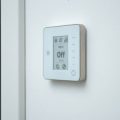Understanding Smart Lighting Basics
Creating the perfect mood in your home starts with understanding the basics of smart lighting. Whether youre setting a cozy atmosphere for movie night or brightening up your kitchen for cooking, smart lighting gives you full control over brightness, color, and scheduling—all from your phone or voice assistant.
Types of Smart Bulbs
There are several types of smart bulbs available on the market, and each serves different needs. Heres a quick comparison to help you choose:
| Type | Features | Best For |
|---|---|---|
| White-only LED Bulbs | Adjustable brightness, energy efficient | Everyday use in kitchens, bedrooms, hallways |
| Tunable White Bulbs | Adjusts between warm and cool white tones | Mimicking natural light throughout the day |
| Color-changing Bulbs (RGB) | 16 million colors, customizable scenes | Entertainment areas, parties, mood lighting |
Smart Lighting Systems
Smart lighting can be controlled individually by bulb or as part of a larger system. Here are some common systems to consider:
| System | Description | Hub Required? |
|---|---|---|
| Philips Hue | Highly customizable, works with most platforms | Yes (for full features) |
| LIFX | No hub needed, Wi-Fi based, vivid colors | No |
| Sengled Smart Bulbs | Affordable option, works with Zigbee hubs like Echo Plus | Some models require hub |
Integration with Home Automation Platforms
The real power of smart lighting comes when you integrate it with home automation platforms. This allows for voice commands, routines, and remote access. Below is how popular platforms work with smart lights:
| Platform | Main Features |
|---|---|
| Amazon Alexa | Create voice commands like “Alexa, set movie time,” group lights by room or scene. |
| Google Home | Easily syncs with Google Assistant; supports routines and voice controls. |
| Apple HomeKit | Tight privacy controls; control via Siri and Apple devices. |
Why Understanding These Basics Matters
Getting familiar with these smart lighting fundamentals helps you make better decisions when choosing products and setting up scenes that fit your lifestyle. Once you know what’s possible—like dimming lights gradually at bedtime or setting colorful scenes for holidays—you’ll find endless ways to personalize your space.
Quick Tips:
- If youre new to smart lighting, start small—maybe just one room.
- Choose bulbs compatible with your existing smart home platform.
- Test out different color temperatures to see what feels best for different times of day.
This foundation will prepare you for creating more advanced lighting scenes and schedules tailored to your daily routine and moods.
2. Choosing the Right Smart Lights for Your Space
Selecting the right smart lighting for your home is key to creating the perfect mood and maximizing both comfort and functionality. Different rooms have different lighting needs, so it’s important to consider factors like brightness (measured in lumens), color temperature (measured in Kelvins), and energy efficiency when choosing your smart bulbs or fixtures.
Understanding Brightness Levels
The amount of light you need depends on how you use each space. For example, a kitchen may require brighter lights for cooking, while a bedroom benefits from softer, dimmable lighting to create a relaxing atmosphere.
| Room | Recommended Brightness (Lumens) |
|---|---|
| Living Room | 1,500–3,000 lumens |
| Kitchen | 4,000–8,000 lumens |
| Bedroom | 1,000–2,000 lumens |
| Bathroom | 4,000–6,000 lumens |
| Home Office | 3,000–6,000 lumens |
Choosing the Right Color Temperature
Color temperature affects how a room feels. Warmer tones (lower Kelvin numbers) create a cozy vibe, while cooler tones (higher Kelvin numbers) are energizing and ideal for tasks.
| Kelvin Range | Light Appearance | Best For |
|---|---|---|
| 2700K – 3000K | Warm White | Bedrooms, Living Rooms |
| 3500K – 4100K | Cool White | Kitchens, Bathrooms |
| 5000K – 6500K | Daylight | Home Offices, Garages |
Energy Efficiency Matters Too
Smart LED bulbs are not only convenient but also energy-efficient. Look for ENERGY STAR certified options to save on electricity bills over time. These bulbs typically last longer and use significantly less power than traditional incandescent bulbs.
Tips for Picking Energy-Efficient Smart Lights:
- Look for Lumens, Not Watts: Lumens measure brightness; watts measure energy use.
- Choose LED over CFL or Incandescent: LEDs consume up to 80% less energy.
- Select Dimmable Bulbs: They help conserve energy and extend bulb life when used at lower settings.
- Opt for Smart Features: Features like motion sensors and scheduling add convenience and reduce unnecessary usage.
The right combination of brightness, color temperature, and energy efficiency can completely transform your home’s ambiance. By tailoring your smart lighting choices to each rooms purpose and mood, you’ll set the stage for more comfortable and functional living spaces.

3. Creating Customized Lighting Scenes
Smart lighting isnt just about turning lights on or off—its about setting the perfect mood for every moment. Whether youre relaxing after work, hosting a dinner party, or getting ready for bed, creating personalized lighting scenes can help enhance your experience. With smart lighting apps and voice assistants like Alexa, Google Assistant, or Siri, it’s easier than ever to customize your home’s atmosphere.
Why Use Customized Lighting Scenes?
Lighting affects our mood, productivity, and comfort. By setting up specific lighting scenes tailored to your daily routines and special occasions, you can:
- Create a cozy ambiance for movie nights
- Add a romantic glow to dinner dates
- Energize your mornings with bright, cool light
- Wind down in the evening with soft, warm tones
Popular Scene Ideas to Try
You can name and program different lighting scenes based on your lifestyle. Here are some common ideas:
| Scene Name | Description | Suggested Light Settings |
|---|---|---|
| Movie Night | Dims lights to reduce glare and create a theater-like experience | Warm white at 20–30% brightness |
| Romantic Dinner | Adds a soft, intimate glow for dining | Candlelight tone at 40% brightness |
| Morning Wake-Up | Mimics sunrise to gently wake you up | Cool white gradually increasing from 0% to 100% |
| Focus Time | Keeps you alert while working or studying | Bright cool white at 100% |
| Bedtime Wind-Down | Lowers energy levels before sleep | Warm amber at 10–20% brightness |
How to Set Up Your Scenes
- Select Your Smart Lighting App: Use platforms like Philips Hue, LIFX, or the app that came with your smart bulbs.
- Create a New Scene: Choose the rooms and lights involved. Adjust color temperature and brightness as needed.
- Name Your Scene: Pick something memorable like “Cozy Reading” or “Dinner Party.”
- Add Voice Commands: Link your scene with voice assistants so you can say things like “Alexa, turn on Movie Night.”
Troubleshooting Tips:
- If your scene doesn’t activate correctly, check that all devices are online and connected to Wi-Fi.
- You may need to update your app or device firmware for better compatibility.
The beauty of smart lighting is that you’re not stuck with one look—customize and experiment until your space feels just right.
4. Setting Schedules for Daily Convenience
One of the best features of smart lighting is the ability to set schedules that align with your daily routine. Whether you’re an early riser or a night owl, automated lighting can make your day smoother and more comfortable.
Wake Up Easier with Gradual Brightening
Instead of waking up to a blaring alarm in a dark room, schedule your bedroom lights to slowly brighten like a sunrise. This gentle increase in light can help you wake up more naturally and feel less groggy in the morning.
Stay on Track During the Day
You can program different rooms with specific lighting scenes throughout the day. For example, your home office can have bright white light during work hours to boost focus, while your kitchen lights can automatically turn on before dinner time.
Wind Down at Night for Better Sleep
Good sleep hygiene starts with reducing blue light exposure before bed. Set your living room or bedroom lights to dim gradually in the evening and shift to warmer tones. This signals your body its time to relax and get ready for sleep.
Sample Lighting Schedule
| Time | Room | Lighting Scene |
|---|---|---|
| 6:30 AM | Bedroom | Gradual Brightening (Warm White) |
| 9:00 AM – 5:00 PM | Home Office | Cool White Task Lighting |
| 6:00 PM | Kitchen | Bright Neutral for Cooking |
| 8:30 PM | Living Room | Dimming Warm Light for Relaxing |
| 10:00 PM | Bedroom | Soft Amber Light, Low Intensity |
Tips for Getting Started with Scheduling
- Use Your App: Most smart lighting systems come with easy-to-use mobile apps where you can set schedules by room and time.
- Create Scenes: Save your favorite brightness and color settings as “scenes” to use in different parts of your day.
- Sync with Sunrise/Sunset: Some systems let you sync lights with natural daylight patterns for an even more natural feel.
- Edit as Needed: Your routine might change—don’t forget you can adjust schedules anytime!
Simplifying your daily life with scheduled lighting not only adds convenience but also helps support better energy levels and sleep habits throughout the day.
5. Integrating Smart Lighting with Your Smart Home
Smart lighting becomes even more powerful when its connected with other smart devices in your home. By syncing your lights with gadgets like thermostats, security systems, and motorized blinds, you can create a seamless and immersive environment that fits your lifestyle.
Why Integration Matters
When your devices work together, you dont just get convenience—you get a smarter living experience. Imagine the lights dimming automatically when the thermostat switches to evening mode or brightening up when your security system detects motion outside. These small changes make a big difference in comfort and energy efficiency.
Popular Devices to Sync with Smart Lighting
| Device | Integration Benefit |
|---|---|
| Thermostats (e.g., Nest, Ecobee) | Lights adjust based on temperature settings or time of day for energy savings and comfort. |
| Security Systems (e.g., Ring, ADT) | Lights flash or turn on during alerts to draw attention or deter intruders. |
| Smart Blinds/Shades | Coordinate natural light with artificial lighting for ideal ambiance throughout the day. |
| Voice Assistants (e.g., Alexa, Google Assistant) | Easily control lighting scenes with voice commands as part of broader routines. |
Creating Personalized Scenes with Multiple Devices
You can take things further by setting up custom scenes using your favorite smart home app or hub. For example:
“Movie Night” Scene:
- Dim living room lights to 30%
- Close motorized blinds
- Set thermostat to a cozy temperature
“Wake Up” Scene:
- Gradually increase bedroom light brightness over 10 minutes
- Open blinds to let in natural light
- Bump up thermostat for morning warmth
Using Routines and Automations
Most smart home platforms allow you to set routines that trigger multiple actions at once. These automations save time and help maintain the mood you want without constant manual adjustments. Whether youre arriving home, going to bed, or hosting friends, one tap—or even no tap—can set the perfect vibe.
Tips for Better Integration
- Use a central hub: Consider using platforms like Apple HomeKit, Google Home, or Samsung SmartThings for smoother device coordination.
- Name devices clearly: This makes it easier to manage them via apps or voice commands.
- Create zones: Group devices by room or function to simplify scene setup.
The key to a truly smart home is not just having smart devices—but making sure they all work together. When your lighting syncs seamlessly with other elements of your home, everyday life becomes more comfortable, efficient, and enjoyable.


